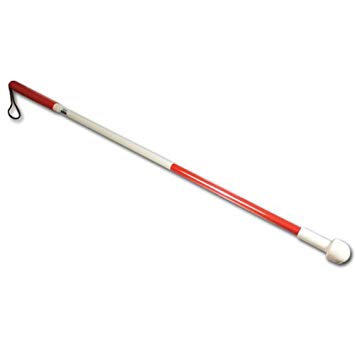What are Kiddie Canes, Pre-Canes, and Alternative Mobility Devices?
The long cane used by some people with visual impairments has a white shaft, a black handle, and is red near the bottom. The long cane provides a traveler with information about the ground in front of him as he moves. There are several alternative types of mobility devices that children with visual impairments who are very young or who have additional disabilities can utilize. These devices, which are similar in function to the long cane, include kiddie canes and adapted canes, also known as pre-canes or alternative mobility devices. Additionally, children’s push toys, such as play lawn mowers, “corn poppers,” etc. have also been used as alternatives for more formal mobility devices.
Kiddie Canes/Pre-Canes
Kiddie canes are small sized canes, whose overall design and grip meet the needs of very young children. These canes are light weight, have a rounded tip that glides easily, a grip with a groove for correct finger placement, and a wrist strap. They resemble the long white cane in appearance.
Adapted Canes/Alternative Mobility Devices (AMDs)
Adapted canes and alternative mobility devices fall into two basic categories: modified straight canes and modified walkers. Each device has its own advantages and disadvantages. Selection of one device over another is specific to an individual student’s needs.
Adapted or modified straight canes include T-bar handled canes with conventional or slightly rounded tips, T-bar handled canes with wheels, and T-bar base push probes that are fitted with wheels.
Alternative mobility devices are shaped like frames or modified walkers and provide protection across the full width of the traveler’s body. These canes are usually rectangular polyvinyl chloride (PVC) frames made from PVC piping and coupling joints. Some are actually orthopedic walker devices that have been modified to glide along the ground in front of the child. Some walker-type, alternative mobility devices have glides on either side that resemble sled runners. Others have rollers fitted to a bottom crossbar, and still, others have a bottom cross bar to which wheels have been attached.
How Can Parents and Teachers Decide What Device (if Any) to Use?
O&M instructors generally think of using adapted canes, pre-canes, and alternative mobility devices when students experience difficulty handling the conventional long cane. Students who have a difficult time grasping the conventional cane’s grip, swinging an arc with the long cane, or interpreting the long cane’s feedback, often benefit from learning to use adapted canes, pre-canes, or alternative mobility devices.
The determination about whether a student should use a kiddie cane, adapted cane, or alternative mobility device; how to select the most appropriate device; when to introduce the device; and how the device is to be fabricated should be made by a qualified O&M instructor working closely with families and school personnel, including a student’s physical therapist if applicable.
Regardless of whether mobility professionals are recommending an AMD or pre-cane or the long cane, some families are hesitant about having their child use any type of mobility device. They may feel that the device will call unwanted attention to their child, may be in the way during family outings, or may be too complicated for their child to learn to use. Other families may embrace a mobility device because they believe it helps the public understand that their child is visually impaired, allows their child greater independence, and prepares the child for future travel either alone or with less support.
What Can Young Children Learn from Using Pre-Canes and Alternative Mobility Devices?
As teachers of orientation and mobility (O&M) have gained increasing experience teaching travel to young children, growing numbers of O&M instructors and families have come to consider mobility device instruction a vital component of O&M training for young children with severe visual impairments. Use of kiddie canes and alternative mobility devices has been associated with the emergence of free movement and exploration, quick and sure gait patterns, efficient muscle use, good posture, muscle strength, and coordination.
Young children who use adapted canes, pre-canes, and alternative mobility devices learn to probe the environment to gather information about obstacles and other details such as drop-offs and changes in texture of the underfooting along the travel path. They learn to use the information about their surroundings conveyed by the devices for staying oriented and for avoiding possible injury.
If your child is using an AMD, pre-cane, or long cane at school, arrange to observe a lesson so you can see what he is able to do with the mobility device. If your schedule doesn’t allow you to observe in person, ask the school personnel to make a videotape or to take pictures for you.
Do the Terms “Pre-Cane” and “Alternative Mobility Device” Mean the Same Thing?
Teachers and parents may hear the terms alternative mobility device and pre-cane device used interchangeably. Usually, the device that resembles a frame fabricated of PVC piping is called an alternative mobility device. This term, however, is not specific, because a variety of devices with frame designs have been referred to as pre-canes. The term pre-cane is also a misnomer because it implies preparation for long cane use. While this may be true for some very young students, a pre-cane, or alternative mobility device, is often the mobility device that may best meet the needs of students who do not go on to use a long cane.
How Can Kiddie Canes, Pre-Canes, and Non-Canes be Obtained?
Various models of kiddie canes, pre-canes, and alternative mobility devices are available through the commercial catalog suppliers of adaptive equipment for people who are blind or visually impaired. Additionally, some O&M specialists fabricate and sell pre-canes and alternative mobility devices through their private consulting businesses. These products may be advertised in the Journal of Visual Impairment & Blindness, Re:View, and regional O&M newsletters. In many instances, pre-cane or non-canes devices are designed and fabricated by O&M instructors for individual students.


